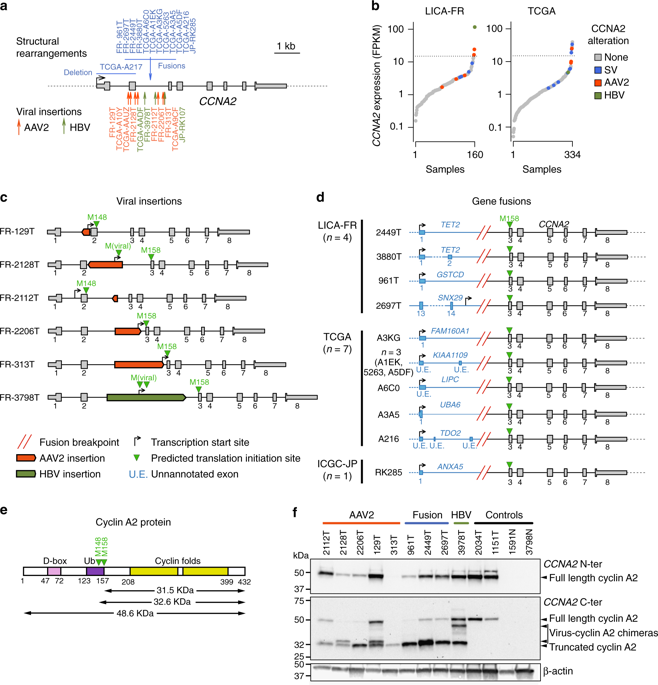当前位置:
X-MOL 学术
›
Nat. Commun.
›
论文详情
Our official English website, www.x-mol.net, welcomes your
feedback! (Note: you will need to create a separate account there.)
Cyclin A2/E1 activation defines a hepatocellular carcinoma subclass with a rearrangement signature of replication stress.
Nature Communications ( IF 14.7 ) Pub Date : 2018-12-07 , DOI: 10.1038/s41467-018-07552-9 Quentin Bayard , Léa Meunier , Camille Peneau , Victor Renault , Jayendra Shinde , Jean-Charles Nault , Iadh Mami , Gabrielle Couchy , Giuliana Amaddeo , Emmanuel Tubacher , Delphine Bacq , Vincent Meyer , Tiziana La Bella , Audrey Debaillon-Vesque , Paulette Bioulac-Sage , Olivier Seror , Jean-Frédéric Blanc , Julien Calderaro , Jean-François Deleuze , Sandrine Imbeaud , Jessica Zucman-Rossi , Eric Letouzé
Nature Communications ( IF 14.7 ) Pub Date : 2018-12-07 , DOI: 10.1038/s41467-018-07552-9 Quentin Bayard , Léa Meunier , Camille Peneau , Victor Renault , Jayendra Shinde , Jean-Charles Nault , Iadh Mami , Gabrielle Couchy , Giuliana Amaddeo , Emmanuel Tubacher , Delphine Bacq , Vincent Meyer , Tiziana La Bella , Audrey Debaillon-Vesque , Paulette Bioulac-Sage , Olivier Seror , Jean-Frédéric Blanc , Julien Calderaro , Jean-François Deleuze , Sandrine Imbeaud , Jessica Zucman-Rossi , Eric Letouzé

|
Cyclins A2 and E1 regulate the cell cycle by promoting S phase entry and progression. Here, we identify a hepatocellular carcinoma (HCC) subgroup exhibiting cyclin activation through various mechanisms including hepatitis B virus (HBV) and adeno-associated virus type 2 (AAV2) insertions, enhancer hijacking and recurrent CCNA2 fusions. Cyclin A2 or E1 alterations define a homogenous entity of aggressive HCC, mostly developed in non-cirrhotic patients, characterized by a transcriptional activation of E2F and ATR pathways and a high frequency of RB1 and PTEN inactivation. Cyclin-driven HCC display a unique signature of structural rearrangements with hundreds of tandem duplications and templated insertions frequently activating TERT promoter. These rearrangements, strongly enriched in early-replicated active chromatin regions, are consistent with a break-induced replication mechanism. Pan-cancer analysis reveals a similar signature in BRCA1-mutated breast and ovarian cancers. Together, this analysis reveals a new poor prognosis HCC entity and a rearrangement signature related to replication stress.
中文翻译:

细胞周期蛋白A2 / E1激活定义了肝细胞癌亚类,具有复制应激的重排特征。
细胞周期蛋白A2和E1通过促进S期进入和发展来调节细胞周期。在这里,我们确定了肝细胞癌(HCC)亚组,其通过多种机制表现出细胞周期蛋白激活,包括乙型肝炎病毒(HBV)和2型腺相关病毒(AAV2)插入,增强子劫持和复发性CCNA2融合。细胞周期蛋白A2或E1改变定义了侵袭性HCC的同质实体,主要发生在非肝硬化患者中,其特征在于E2F和ATR途径的转录激活以及RB1和PTEN失活的频率很高。细胞周期蛋白驱动的肝癌表现出独特的结构重排特征,具有数百个串联重复和模板化插入,经常激活TERT启动子。这些重排在早期复制的活性染色质区域中非常丰富,与断裂诱导的复制机制一致。泛癌分析揭示了在BRCA1突变的乳腺癌和卵巢癌中具有相似的特征。总之,该分析揭示了一个新的预后不良的HCC实体和与复制压力有关的重排标志。
更新日期:2018-12-07
中文翻译:

细胞周期蛋白A2 / E1激活定义了肝细胞癌亚类,具有复制应激的重排特征。
细胞周期蛋白A2和E1通过促进S期进入和发展来调节细胞周期。在这里,我们确定了肝细胞癌(HCC)亚组,其通过多种机制表现出细胞周期蛋白激活,包括乙型肝炎病毒(HBV)和2型腺相关病毒(AAV2)插入,增强子劫持和复发性CCNA2融合。细胞周期蛋白A2或E1改变定义了侵袭性HCC的同质实体,主要发生在非肝硬化患者中,其特征在于E2F和ATR途径的转录激活以及RB1和PTEN失活的频率很高。细胞周期蛋白驱动的肝癌表现出独特的结构重排特征,具有数百个串联重复和模板化插入,经常激活TERT启动子。这些重排在早期复制的活性染色质区域中非常丰富,与断裂诱导的复制机制一致。泛癌分析揭示了在BRCA1突变的乳腺癌和卵巢癌中具有相似的特征。总之,该分析揭示了一个新的预后不良的HCC实体和与复制压力有关的重排标志。











































 京公网安备 11010802027423号
京公网安备 11010802027423号